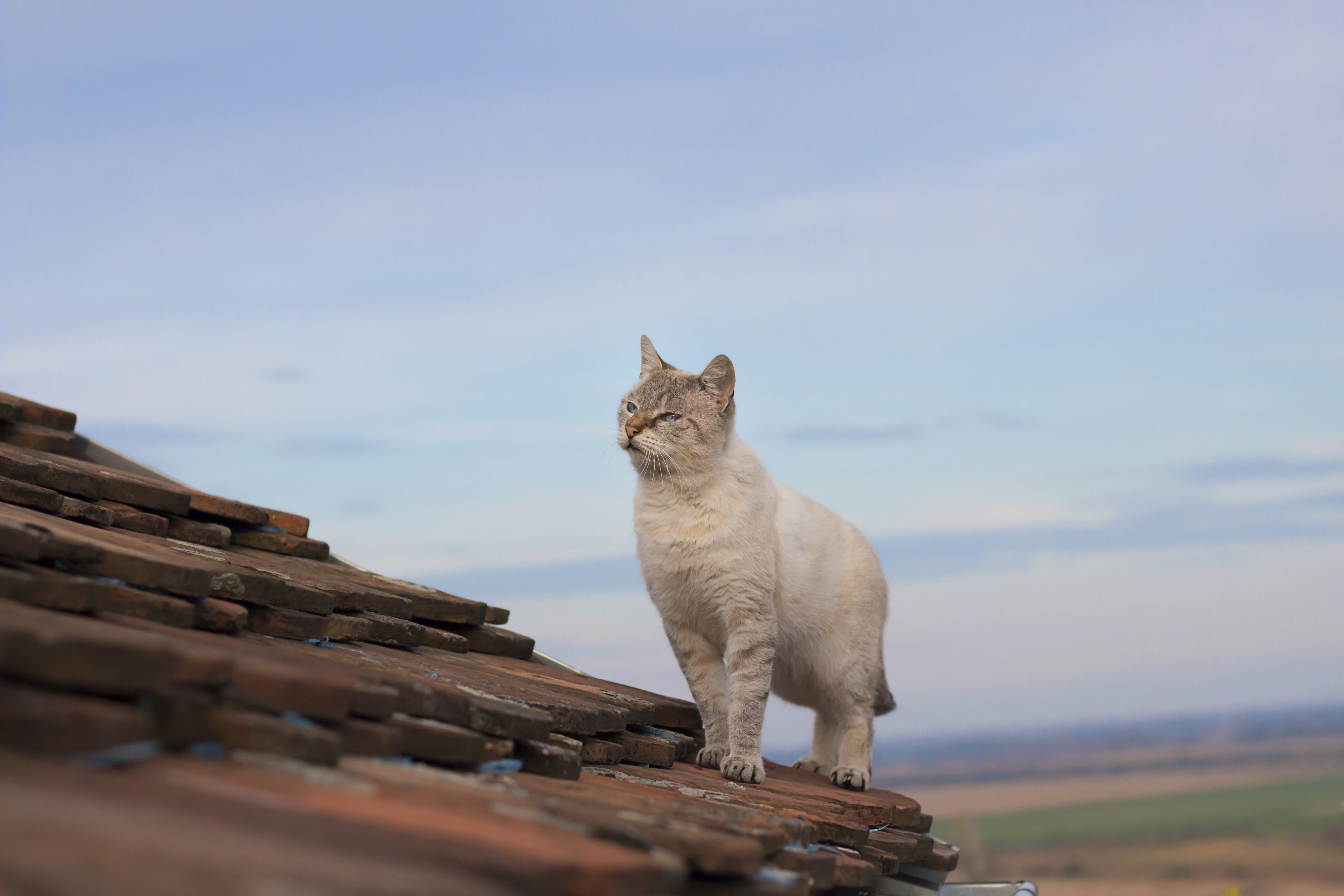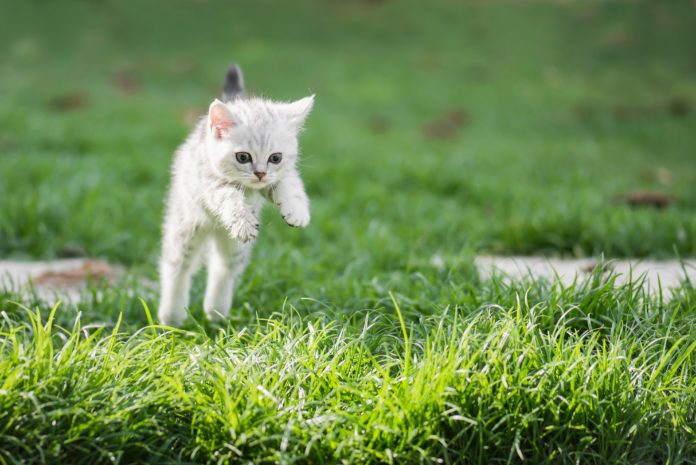When your cat develops a problem that might be neurologic, get her right to your veterinarian. There’s no time to waste.
Your cat will likely receive a general physical exam, blood work, a thorough eye and ear exam, and also a specialized neurologic physical examination.
Your veterinarian will check for proprioception (awareness of body position in space) by flipping your cat’s paws over to see if she recognizes the paw is upside down. Your cat may do some “hopping” exercises to see how each foot and leg responds to movement challenges. These tests may look silly, but they can relay serious information about how your cat’s body provides feedback to the brain about its position in space and the brain’s response to changes in body position.
Some neurologic problems are secondary to other problems, such as a buildup of toxins due to liver damage or a head tilt and balance problems as a result of an ear infection.
The first neurologic problems seen in cats can show up in young kittens. The kitten that is adorably clumsy may actually have a congenital (present at birth) defect in his cerebellum. The cerebellum controls balance and coordination, so problems in that part of the brain are manifested as clumsiness and an uncoordinated gait. This condition generally results from an infection with feline distemper virus in the unborn kitten. While these kittens are clearly not normal, they can live a full life with some extra caution to help keep them safe from stairs, etc.
In senior cats, cancer is a concern. Meningiomas are the most common brain tumor in cats. This tumor develops in the membranous cover of the brain. Luckily, it is generally cured by surgical removal. A wide range of clinical signs may be noted, depending on what part of the brain this cancer grows in.
Hyperesthesia
In adult cats, two common neurologic problems are hyperesthesia and epilepsy (seizures). Hyperesthesia is an extreme sensitivity in an area of your cat’s skin. This is almost always on the back, right in front of the tail.
This is usually noticed when you go to pet that area and suddenly your cat reacts. The response may be as benign as simply going to scratch the area herself or it may be a bite headed your way. Pupils may be dilated, and there may be drooling. You may notice intensive scratching and digging at the spot. Some cats may vocalize or urinate. While your cat’s response may be unpleasant, the real problems are the potentially self-mutilating behaviors and, of course, the underlying sensations (i.e. discomfort) that cause this behavior.
While some veterinarians feel this is related to obsessive-compulsive disorders, Dr. Alexander (Sandy) de Lahunta, emeritus professor at Cornell University College of Veterinary Medicine and a renowned pioneer in veterinary neurology, says it could be representative of a seizure-type problem. Siamese cats may have a genetic predisposition, so cats showing this disorder should probably not be bred.
To diagnose hyperesthesia, other causes need to be ruled out. That means looking for any cause of pain in the sensitive area, such as spinal arthritis and skin problems, including parasites, allergies, and fungal infections.
Dr. Emma Davies BVSc MSc, lecturer in neurology in the Cornell University Hospital for Animals, emphasizes that underlying causes need to be evaluated. “The most important thing in cats with hyperesthesia is making sure that there is nothing causing the hyperesthesia that we can identify and treat. Cats can have intervertebral disc extrusions and many other disorders that can result in hyperesthesia. If we cannot identify a cause then we can certainly treat it symptomatically. Gabapentin (a drug frequently used to control epileptic seizures) works well, but otherwise it depends where they are hyperesthetic. We have worked with anesthesia to perform a local epidural injection in animals with lumbosacral or tail pain.”
Anxiety and stress seem to add to a cat’s hyperesthetic reaction, so a treatment plan will often include some behavioral aspects. This might include medications to affect behavior and/or establishing a routine to minimize stress associated with change for your cat. Luckily, most cats can be managed and continue to lead happy, active lives.

Epilepsy
Epilepsy is not as common in cats as it is in dogs, but it can be devastating to affected pets and their owners. Epilepsy, or seizures, can be secondary to other medical problems. Trauma, such as being hit by a car, may lead to seizures.
A brain tumor or a metabolic disorder, such as liver damage with a buildup of toxins or diabetes with a blood glucose irregularity, can lead to seizures. Dr. Davies notes, “The cause of seizures in cats varies. In young cats, it may be infectious causes, such as FIP or toxoplasma, and rarely an inflammatory cause, or in older cats it may be hypertension (high blood pressure), neoplasia (cancer), or metabolic causes.”
An MRI (magnetic resonance imaging) or CAT (computer-assisted tomography) map of your cat’s brain may be done to rule out any problems, such as tumors. Just as with dogs, however, an underlying cause for a cat’s brain “short circuits” and seizure activity is often not identified. In these cases, the seizures are termed “idiopathic epilepsy.” With epilepsy, it is important that you keep a record of when your cat experiences seizures and any factors that might have contributed. Record the time and duration of the seizure, how it started, and any possible factors that might contribute to seizure activity. Cats with idiopathic epilepsy may cry and urinate or defecate while seizing. Once they come out of the seizure and have a period of recovery (since seizures are physically exhausting), they will commonly return to perfectly normal behavior.
Seizures are usually controlled medically. “I feel that phenobarbital works very well to control seizures in cats, especially as they do not seem to demonstrate many of the side effects that afflict dogs,” says Dr. Davies. Phenobarbital is often the first drug of choice, as it is relatively inexpensive. If this does not control your cat’s seizures, other medications can be tried. In some stubborn cases, a combination of medications may be required.
Seizure medications need to be given consistently, the same time of day and every day. Stopping medications can lead to the onset of seizures. Each time your cat has a seizure, the abnormal pattern of electrical activity in the brain is reinforced, increasing the likelihood of future seizures. The goal of administering seizure medications is to control, not cure, seizures.
Occasionally a cat may have a breakthrough, even though she is normally well controlled on her medications. If your cat goes into “status epilepticus,” or recurring seizures, you need to contact your veterinarian immediately. Your cat will require emergency treatment to keep his brain from overloading and to prevent him from developing a potentially fatal rise in body temperature.
For more information, visit http://www.vet.cornell.edu/fhc/health_information/neurologicdisorders.cfm.

Idiopathic Vestibular Problems
The term “idiopathic” means of unknown cause
An idiopathic vestibular problem is a fairly benign neurologic condition often noted in late summer or early fall. You may notice your cat walking as if drunk, tilting her head to one side, rolling, or falling. Often her eyes will move back and forth rapidly (nystagmus). She may vomit or cry out.
Your veterinarian will do a careful exam to rule out potential causes, such as an ear infection. Once it appears that this is truly vestibular disease, your cat will be treated symptomatically with medications to help with nausea and balance.
Your nursing care is important. You will need to keep her confined and safe, so she can’t hurt herself wandering or rolling around. Encourage her to eat and drink. Fortunately, this syndrome tends to be short-lived, and most cats are back to normal within a week to 10 days.
Seizures are Multi-Faceted Events
From start to finish, learn the different stages of a seizure
Pre-ictal or aura: Usually within minutes to an hour before a seizure, your cat may act nervous, lick her lips, or drool. Some cats will hide.
Seizure or ictus: Your cat loses consciousness, generally falls to one side, legs may move, urination or defecation may occur, there may be vocalization. This description fits a grand mal seizure.
Post-ictal: After the seizure activity stops, your cat may be very tired or do some nervous pacing. Her appetite may be increased. This period can last up to a day, but is generally only a few hours long.




